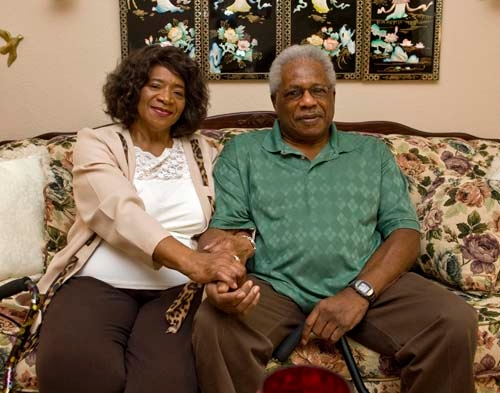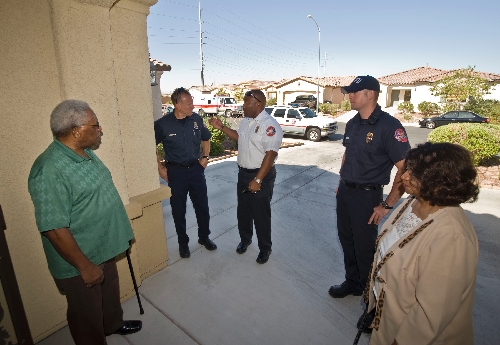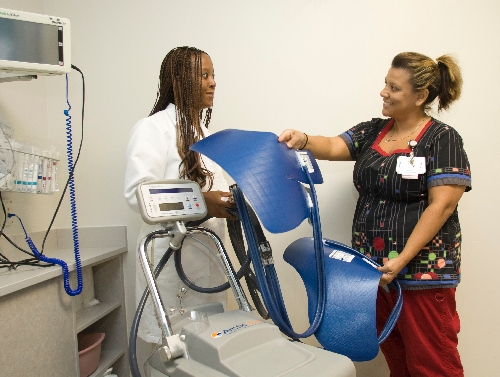Quick response, new technique help heart attack victim
You're not taking much poetic license when you say that 68-year-old Robert Mallory died, but lived to tell the tale.
And for that he has to thank his wife and his daughter and paramedics and doctors and nurses and respiratory therapists. ...
And therapeutic hypothermia, a deliberate lowering of his body temperature that can reduce brain damage and increase survivability after cardiac arrest.
"It's kind of amazing that I'm still here today talking to you with no real ill effects," the U.S. Navy retiree said as he sat next to his wife, Johnnie, in their North Las Vegas home.
Truer words were never spoken by a man whose heart stopped beating.
About 6 percent of the 325,000 Americans who suffer sudden cardiac arrest each year survive it. Mallory is among an even smaller fraction -- about 3 percent -- who come through it without brain damage.
"I'm not sure I've seen a case where people and protocols worked better together," said Dr. Casaundra Lindsey, the Valley Hospital Medical Center emergency room physician who oversaw Mallory's care after he was taken to the hospital by North Las Vegas Fire Department paramedics.
It was Lindsey who decided that Mallory would benefit from the therapeutic hypothermia protocol that would place him in a coma and have his body slowly cooled to around 91 degrees Fahrenheit.
Yet Lindsey is the first to acknowledge that the recently implemented hypothermia treatment -- a protocol adopted by five area hospitals in the last two years -- wouldn't have had a chance to work without the quick thinking of Johnnie Mallory and the fast work of the North Las Vegas Fire Department.
"If the patient isn't resuscitated in time, cooling isn't going to do any good," said Lindsey, a 43-year-old graduate of the Ohio State University College of Medicine.
Shortly after midnight on July 23, Johnnie Mallory heard a sudden, loud, strange sound come from her husband as they lay in bed.
"We've been married for more than 40 years, so I know his sounds," she said. "It was kind of like a growl. I turned on the light and saw his mouth was wide open and his lower body was stiff. I immediately screamed for my daughter to call 911 to say that her daddy had either a heart attack or a stroke."
And then she began cardiopulmonary resuscitation, her chest compressions accompanied prayers and cries of "Robert, wake up."
"My daughter said the fire department told her to get Robert off the bed, so we did," Johnnie Mallory said. "That was hard but we did it and then I started mouth-to-mouth."
Four minutes after the 911 call, records show North Las Vegas Fire Department paramedics showed up.
They restored Mallory's heartbeat with an automated external defibrillator and got him breathing again with CPR.
And they immediately put into play a protocol that their department had started just days before on cardiac patients: Mallory received a cold saline infusion and ice packs were placed around his head and body.
Research has shown that neurological function also can be preserved through cooling by preventing a secondary brain injury that often occurs after successful cardiac resuscitation.
Less than 25 minutes after the 911 call, Lindsey was examining Mallory at Valley.
A week after he was rushed to the hospital unconscious, Mallory walked out with a smile on his face.
"You only wish it would always work this way," Lindsey said. "That kind of speed really gives a patient not only a better chance of survival, but a better quality of life if he does survive."
Last year, Dr. Ross Berkeley, in charge of quality control of the emergency department at University Medical Center, pushed hard to have fire departments work in concert with hospitals offering therapeutic hypothermia treatment. Now the Las Vegas, Henderson and North Las Vegas fire departments are following the cooling protocol.
Within two months, the Clark County Fire Department and MedicWest and American Medical Response ambulances will initiate the cooling protocol.
"This is really cutting edge stuff," said Capt. Cedric Williams of the North Las Vegas Department. "Working with hospitals this way really gives a patient a better chance."
About a dozen fire departments nationwide are following the protocol that researchers have long argued gets therapeutic hypothermia off to a running start.
Lindsey said it is unclear exactly how therapeutic hypothermia works, but two clinical trials published in the same issue of the New England Journal of Medicine in 2002 demonstrated that inducing hypothermia in unconscious patients after cardiac arrest significantly improved their survival rate, as well as neurological outcomes.
One trial performed in Europe found a 14 percent improvement in survival rate, while a second trial in Australia showed a 23 percent improvement in neurological outcomes.
When a patient arrives at a hospital, he is given sedating and paralyzing drugs to prevent shivering.
He also is placed on a ventilator and then gradually chilled over an eight-hour period.
For about 24 hours, the body temperature is held between 90 and 92 degrees while the patient is closely monitored.
Rewarming is gradual, about a degree per hour, as sedation is reduced.
"I don't remember any of it," said Mallory, who has been told by doctors not to return to his job with an armored car company for six months.
While there have been far too few cases locally to scientifically draw conclusions, there is every indication that the cooling protocol is working successfully at UMC, Valley, Sunrise Hospital and Medical Center, and at the St. Rose Dominican Hospitals, Siena and de Lima campuses.
Dr. David Slattery, the Las Vegas Fire Department medical director who is trying to document failures and successes of the cooling protocol, said combined statistics at UMC, Valley and Sunrise reveal a 30 percent survival rate with hypothermia intervention after cardiac arrest. And the percentage of those surviving without brain damage is almost that high.
Remember, without hypothermia intervention after a cardiac arrest the national statistics for survival are only 6 percent, with only 3 percent of the survivors not suffering severe neurological problems.
The area hospitals releasing the most up-to-date statistics in regard to cooling protocols, St. Rose and Valley, give documented reason for hope, with outcomes of cardiac arrest cases with hypothermia intervention far surpassing overall national rates in regard to both brain damage and survival where there is no intervention.
Of the 14 cardiac arrest cases handled at St. Rose with therapeutic hypothermia in conjunction with the Henderson Fire Department, the three survivors were neurologically intact. That's both a 21 percent survival rate and the same percentage for those not suffering brain damage.
Fifty cases handled with the cooling protocol at Valley have shown a 37 percent survival rate, while 23 percent of the patients have gone home and done well, according to Dr. Jeffrey Davidson, an administrator with the hospital's emergency department. He said 14 percent had to go to long-term acute care.
"We can't stress enough how important it is for people to learn CPR and to immediately dial 911," Davidson said. "That's the real key. The cooling doesn't work if you don't get the people going again. No time can be wasted."
Because doctors couldn't find a reason why Robert Mallory's heart stopped, a defibrillator was implanted in his chest. If his heart stops again, the device should shock it back into rhythm.
He has taken to using a cane since his cardiac arrest.
"The only thing I can say is that I'm a little shakier on my feet since it happened, but I'm getting stronger every day," Mallory said as he squeezed his wife's hand. "I won't need the cane much longer. I'm ready to go on with just a normal life. I'm just glad everybody knew what to do."
Contact reporter Paul Harasim at pharasim@reviewjournal.com or 702-387-2908.



















